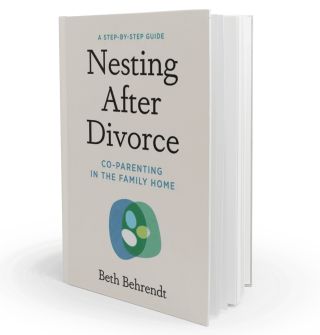This Article was originally published at Psychology Today on April 17, 2023
KEY POINTS
- Studies show that divorce may be a trauma-inducing experience, undermining a child’s sense of safety, stability, and bonding.
- In the same way birds fly in and out of the nest to care for their babies, divorced parents can rotate in and out of the family home.
- Children benefit from the consistency of staying in their home and maintaining the regularities of daily life that matter to them.
Unlike the traditional two-home divorce, “nesting” or “bird nesting” is a child-focused approach to co-parenting, where the children continue to live in the family home after the parents have separated or divorced. In much the same way that birds fly in and out of the nest to care for their fragile baby birds, mothers and fathers rotate in and out of the family home base, and children stay put in comfort and safety as they grow.
Beth Behrendt is the author of Nesting After Divorce: Co-Parenting in the Family Home. Here’s a conversation with Beth about this positive trend and her personal experience embracing this method for her family.

Lynne: Several years ago, you were approaching a divorce and had young children. How did you come to think about taking a different approach?
Beth: As my ex and I were parting ways, I came across the concept of nesting while I was reading about divorce. We both agreed we wanted to give it a try for the benefit of our children. Though we loved the concept, it took trial and error and continually making adaptions to our plan as our life circumstances evolved to figure out what worked best. We’ve been extremely pleased with this approach and its benefits to our family.
Lynne: Several years ago, you were approaching a divorce and had young children. How did you come to think about taking a different approach?
Beth: As my ex and I were parting ways, I came across the concept of nesting while I was reading about divorce. We both agreed we wanted to give it a try for the benefit of our children. Though we loved the concept, it took trial and error and continually making adaptions to our plan as our life circumstances evolved to figure out what worked
Lynne: Why was it important for you to give this approach a try?
Beth: Studies show that divorce can be a trauma-inducing experience, undermining a child’s sense of safety, stability, and bonding. The United States has one of the highest divorce rates in the world, and a report released in August 2021 suggests that divorce filings increased by 21 percent from the first year of the pandemic to the second; a larger percentage than ever before came from couples with children under the age of 18.
Lynne: Can you offer specific examples of how nesting has helped your family?
Beth: The family therapist my sons had been seeing for a couple of years after we divorced asked to speak with me one-on-one after a session with one of the boys. She wanted to share with me that my children had never once brought up our divorce as an issue, even when she asked them specifically about it. She said that in all her years of counseling, my children were the only ones she’d encountered who didn’t consider their parents’ divorce to be a stressful event in their lives, and she credited our nesting situation for being a large part of that.
More recently, as our middle child was a junior in high school and was working on essays for college applications, I offered the unsolicited advice that perhaps he could include how growing up in a nesting home immersed him in creativity and problem-solving and the importance of family. He merely scoffed, “Mom, I don’t think you realize how little your and Dad’s divorce affected me. Like, not at all.”
Lynne: How has it affected your relationship with your ex-husband?
Beth: Nesting led to a better relationship with my ex than I could have imagined. I certainly didn’t go into nesting with the goal of becoming friends with him—we were getting divorced, after all. But figuring out nesting together, interacting frequently in front of the kids, learning to communicate better, and enjoying the success of our hard work on co-parenting led us to a much better relationship than we had even when we were married.
Lynne: Is there a single way to do nesting right?
Beth: There are a wide variety of approaches families have taken to make it work well for their specific circumstances. While we all share similar goals and have dealt with similar issues, there is no one-size-fits-all approach. The common lesson is that nesting—and divorce itself—requires cooperation and creativity.
Lynne: Is nesting right for every family facing divorce?
Beth: Even if your separation is contentious, I advise people to still consider nesting. There are many ways to set up rules and guidelines to limit your interaction with each other while still allowing your children to benefit from the consistency of staying in their home and maintaining the regularities of daily life that matter to them. That said, before you make the decision to give nesting a try, you should consider whether or not nesting is in the best interest of you or your children. Please consider professional advice if you have concerns.



Leave a Reply